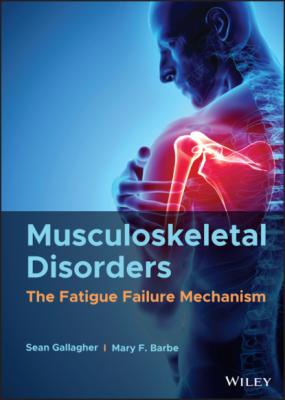ТОП просматриваемых книг сайта:
Musculoskeletal Disorders. Sean Gallagher
Читать онлайн.Название Musculoskeletal Disorders
Год выпуска 0
isbn 9781119640134
Автор произведения Sean Gallagher
Жанр Здоровье
Издательство John Wiley & Sons Limited
Summary
This chapter discussed the main non‐neural tissue types that comprise the musculoskeletal system. Tables 3.1–3.5 summarize each tissue type in detail under normal uninjured conditions, Table 3.7 summarizes joints by their main function versus arthrokinematics, while Table 3.8 provides a general summary overview. Differences in these tissues characteristics after injury are discussed in Chapter 11, and their interaction with the nervous system is discussed in Chapter 4.
Table 3.8 Summary of Non‐Neural Tissues of the Musculoskeletal System
| Tissue | Description | Main functions |
|---|---|---|
| Loose connective tissuesAdiposeAreolarReticular | Fibers are loosely woven with many cells, all embedded in a semifluid ground substance. | Provides cushioning, support, elasticity, and immune functions |
| Dense connective tissues ‐IrregularDermis of skinDeep fasciaPeriosteumPerichondrium ‐ RegularTendonCartilageBone | Characterized by regularly or irregularly arranged collagen fibers, and low intercellular substance. Primary cells are fibroblasts or fibroblast like cells in dense irregular connective tissues. Primary cells in tendons are tenocytes, chondrocytes in cartilage, and a number of cells including osteoblast and osteoclasts in bone. | Tendon: Transfer of tensile forces created by muscles onto bone; absorbs sudden shocks to limit muscle damage.Cartilage: Hyaline: Protection of bony surfaces, especially at points of movement; Fibrocartilage: Strength and rigidity, joint support and fusion; Elastic cartilage: Resilience and pliabilityBone: Strength, stability; lever at points of attachment; storage of minerals, lipids and nutrients; blood cell formation |
| Skeletal muscle | Contains contractile cells (myocytes) arranged in multinucleated striated long fibers (myofibers). | Contraction and then movement of the endoskeleton to which the muscle is attached |
| Ligaments | Dense regularly connective tissue with many collagenous fibers arranged into bundles; small number of fibroblastic‐like cells | Support and strength to joints |
Bibliography
1 Ailavajhala, R., Oswald, J., Rajapakse, C. S., & Pleshko, N. (2019). Environmentally‐controlled near infrared spectroscopic imaging of bone water. Scientific Reports, 9(1), 10199. https://doi.org/10.1038/s41598‐019‐45897‐3
2 Ailavajhala, R., Querido, W., Rajapakse, C. S., & Pleshko, N. (2020). Near infrared spectroscopic assessment of loosely and tightly bound cortical bone water. Analyst, 145(10), 3713–3724. https://doi.org/10.1039/c9an02491c
3 Al‐Dujaili, S. A., Lau, E., Al‐Dujaili, H., Tsang, K., Guenther, A., & You, L. (2011). Apoptotic osteocytes regulate osteoclast precursor recruitment and differentiation in vitro. Journal of Cellular Biochemistry, 112(9), 2412–2423. https://doi.org/10.1002/jcb.23164
4 Ali, S., Cunningham, R., Amin, M., Popoff, S. N., Mohamed, F., & Barbe, M. F. (2015). The extensor carpi ulnaris pseudolesion: Evaluation with microCT, histology, and MRI. Skeletal Radiol, 44(12), 1735–1743. https://doi.org/10.1007/s00256‐015‐2224‐3
5 Bakker, A. D., Silva, V. C., Krishnan, R., Bacabac, R. G., Blaauboer, M. E., Lin, Y. C., … Klein‐Nulend, J. (2009). Tumor necrosis factor alpha and interleukin‐1beta modulate calcium and nitric oxide signaling in mechanically stimulated osteocytes. Arthritis Rheum, 60(11), 3336–3345. https://doi.org/10.1002/art.24920
6 Barbe, M. F., Harris, M. Y., Cruz, G. E., Amin, M., Billett, N. M., Dorotan, J. T., … Bove, G. M. (2021). Key indicators of repetitive overuse‐induced neuromuscular inflammation and fibrosis are prevented by manual therapy in a rat model. BMC Musculoskelet Disord, 22(1), 417. https://doi.org/10.1186/s12891‐021‐04270‐0
7 Barbe, M. F., & Popoff, S. N. (2020). Occupational activities: Factors that tip the balance from bone accrual to bone loss. Exercise and Sport Sciences Reviews, 48(2), 59–66. https://doi.org/10.1249/JES.0000000000000217
8 Benjamin, M., & Ralphs, J. R. (1998). Fibrocartilage in tendons and ligaments‐‐an adaptation to compressive load. Journal of Anatomy, 193(Pt 4), 481–494. Retrieved from http://www.ncbi.nlm.nih.gov/pubmed/10029181
9 Bonewald, L. F. (2007). Osteocytes as dynamic multifunctional cells. Annals of the New York Academy of Sciences, 1116, 281–290. https://doi.org/10.1196/annals.1402.018
10 Borynsenko, M., & Beringer, T. (1989). Functional histology (pp. 105–112). Boston: Little, Brown.
11 Boyce, B. F., & Xing, L. (2007). Biology of RANK, RANKL, and osteoprotegerin. Arthritis Research and

